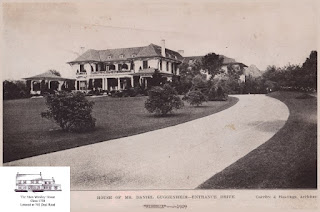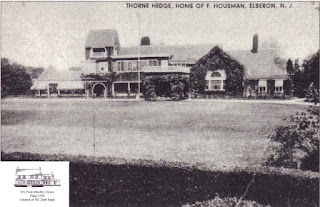Elberon Former Sections
Digital interactions for Friends of the
Township of Ocean Historical Museum!
FORMER SECTIONS OF THE TOWNSHIP OF OCEAN
The area that today is Long Branch, was originally part of Ocean Township until 1904. Long Branch was a colonial-era oceanfront retreat. Long Branch developed into a nationally significant resort in the first half of the 19th Century and it was arguably the most prominent resort by 1860. The Elberon section of the City is today next to Deal and Ocean Township
The 1899 Elberon Railroad Station replaced the earlier station lost to fire. Sixty percent of the station area was taken up by open colonnades. The classic station was destroyed by fire in May 1988.
This is Lakewood Farm's market that used to be on Lincoln Avenue, Elberon
This is the business district on Lincoln Square in 1907
This is the First Aid Squad in front of the Fire House on Lincoln Square at their formation in 1948.
This is Takanassee Lake.
The Church of the President's was consecrated as St. James Protestant Episcopal Chapel in 1879. It was built by members of the St. James Protestant Episcopal Church, on Broadway, by members who lived in Elberon but didn't want to travel all the way to downtown. In 1949 services at the chapel ceased due to a dwindling congregation. The Church of the President's Historical Museum is currently renovating the structure.
The Elberon Memorial Church (named the Moses Taylor Memorial Presbyterian Church) was founded in 1866 and endowed 1886 by Catherine Taylor, in honor of her late husband. Taylor, business agent for John Jacob Astor and President of the Bank of New York, had a summer home in Elberon. The church includes stained glass provided by Louis Comfort Tiffany and an organ designed by Hilborne L. Roosevelt. Its pastors included Dr. Norman Vincent Peale.
Architect Charles A. McKim received his first major commission from Moses Taylor, one of America's wealthiest men. Taylor (whose fortune was estimated at around $70 million and who controlled the National City Bank of New York, a railroad and an import business) hired McKim to design a summer house in Elberon, New Jersey.
Franklyn Cottage, on the northeast corner of Ocean and Lincoln Avenues, was the summer home of Charles Franklyn, President of the Cunard Shipping Lines. Designed by Charles F. McKim and built in 1876, the building is forever associated with the death of President James A. Garfield. Damaged by the 1914 Elberon Hotel fire on the adjoining property, the house was taken down a few years later.
The most photographed of all residences in Elberon is the House that was known as Grant Cottage. Charles W. Clinton of New York designed the stick style residence for Howard Potter, adjacent to the home of his business partner, James M Brown, at Brown Brothers & Co. The house was purchased in 1870 on behalf of President Ulysses S, Grant. Grant owned the property and summered there until 1884. The house existed, with some renovations and in very poor condition, until 1964, when it was purchased by the Catholic Church, which owned the adjoining Stella Maris, and was torn down.
In the late 1800s, the Elberon Hotel was the newest and smartest of the shore hotels. It was located on Ocean Avenue just south of President Grant's summer cottage. It was designed by the New York architectural firm of McKim, Mead, and White. Its success was propelled by President Rutherford B. Hayes's visits. His successor, James A. Garfield was another regular guest. The Hotel was destroyed by fire in 1914.
Daniel Guggenheim (1856-1930), was in his day one of the richest men in the world. After his father Meyer, death in 1905, he became President of American Smelting and Refining Co. (ASARCO) which mined tin, gold, diamonds, copper, and raised rubber around the world. After his father's death, Daniel became the face of a family business described as "success upon success." His summer home in Elberon was named "Firenze."
This amazing mansion was built in 1881 for Cornelius Kingsland Garrison at Elberon, New Jersey. The house was later owned by Mary Guggenheim, daughter of Solomon and wife of Arthur Stewart, 7th Earl of Stewart. The coast of New Jersey, during the Gilded Age, was lined with incredible Victorian mansions, all trying to outdo each other with embellishments of fretwork, stained glass, towers, porches, and exotic details. This local landmark house survived till the mid-1940s, then was demolished.
The estate "Castlewall" was located on Van Court Avenue and was completed in 1882 by William R. Garrison. Garrison was a partner in several shipping companies owned with his father Cornelius Kingston Garrison. Unfortunately, Garrison was killed in a railroad accident in Oceanport, in July 1882, only a few months after the completion of the house. It was later owned by lawyer Myron H. Oppenheim.
George and Harriett "Hattie" Pullmans' primary summer residence was named Fairlawn and was located on Ocean Avenue in the town of Elberon, in the fashionable Long Branch area of New Jersey. They had first visited the area in the summer of 1871 when they stayed with President and Mrs. Grant. In September 1873, they engaged the services of architect Henry S. Jaffray, (then actively at work on their Prairie Avenue home), to design their new summer house in Elberon. Nathan Barrett, the designer who later undertook the master landscape plan for the Town of Pullman, did the landscaping for the expansive grounds. Through Pullman's influence, Barrett was ultimately given the commission for the design and landscape plan for the town of Elberon itself.
The house was completed by June of 1874 and the family typically arrived each summer in time for the Fourth of July holiday. During the summer of 1897, the Pullmans discussed the remodeling and enlarging of Fairlawn with Solon S. Beman, the architect of the Town of Pullman, who had also undertaken a number of additions and improvements to their Prairie Avenue home.
George Pullman died that October, and the rebuilding, in the Colonial Revival style, was not completed until 1900. By that time, the house was generally recognized as the most spacious and attractive summer estate along that section of the Jersey coast. Mrs. Pullman continued to travel to her beloved summer estate each year through the 1920 season.
The H. Victor Newcomb house was also called "Sunny Sands." Mr. Newcomb was President of the Louisville & Nashville Railroad, inherited from his father. In 1880, he organized the United States National Bank in New York along with other directors such ad President U.S. Grant.
In 1891, he had a mental breakdown, attempting to kill Henry M. Flagler, one of the partners in Standard Oil Company, and declaring that explorer Henry M. Stanley had threatened his life. He was committed to a sanitarium.
The house was designed in 1880 by McKim, Mead & White.
The Charles T. Cook residence, located on Lincoln Avenue in the Elberon section of Long Branch. The shingle-style home was designed by the renowned architectural firm of McKim, Mead, and White in 1885. Cook was President of Tiffany and Company as well as a best friend with the owner, Charles Tiffany. Because the Cook and Tiffany families spent so much time together in the summer, the architect was asked to design a home that would comfortably accommodate the two families. The house cost $33,000 to build.
The residence was changed significantly over time. In the 1970s and 1980s, it was the home of State Senator, Dr. Anthony Villane.
The Elberon Casino, designed by Boston's Peabody and Stearns, was built in 1883 at the northeast corner of Lincoln and Elberon Avenues. Casinos, in their 19th-century parlance an upper-class social club, were built in several popular areas appealing to the wealthy.
The Casino was remodeled as a private home. The building survived until 1959 when it was destroyed for the construction of several new houses.



















































































































































